May 21, 2025 | 07:51 GMT +7
May 21, 2025 | 07:51 GMT +7
Hotline: 0913.378.918
May 21, 2025 | 07:51 GMT +7
Hotline: 0913.378.918

The delegation of the Binh Dinh fisheries industry visited the commercial seaweed farming waters of Okinawa Co., Ltd. in Song Cau town (Phu Yen). Photo: V.D.T.
During a visit to study the commercial seaweed farming profession in Phu Yen, a 32-person delegation from Binh Dinh province was determined to study the secrets of seaweed farming from experienced businesses in commercial seaweed farming.
In the 7-hectare commercial seaweed farming area of Okinawa Co., Ltd. in Song Cau town (Phu Yen), Mr. Le Trung Vinh, the person in charge of Okinawa Co., Ltd., shared with the delegation of Binh Dinh fisheries industry that the most effective seaweed farming water area is a shallow, clean, sandy area. On the shore, there must be a sandy beach so that when harvesting, growers have a place to dry seaweed. The reason is that when harvesting, the yield of seaweed is very large.
In particular, the seaweed farming waters must be those without rocky cliffs because the cliffs are the residence of rabbitfish and cobia, while seaweed is the "favorite" of these two species of fish. If seaweed is eaten when it is young (the seaweed seed has only been hanging for about 4-5 days), the seaweed will lose its strength and can't grow. When seaweed is planted in waters without rocky cliffs, the fish will come ashore to hunt for food and eat seaweed only when it’s dark. If seaweed is planted in the waters with rocky cliffs, the fish hiding in the cliffs will eat the seaweed all day and night, unable to stop it.
According to Mr. Vinh, seaweed grown in a shallow-water area will bring more profits to growers. The cause is that seaweed is often broken and falls up to 1/3 due to the waves crashing every day, maybe more in the rough sea season. If planted in a shallow-water area, growers can dive into the sea to recover the fallen seaweed, so there is no loss. If growing seaweed in waters of about 2-3 m depth, the grower must choose a stream of water flowing on the seabed to spread a net to catch the fallen seaweed, then dive to collect it to avoid loss.
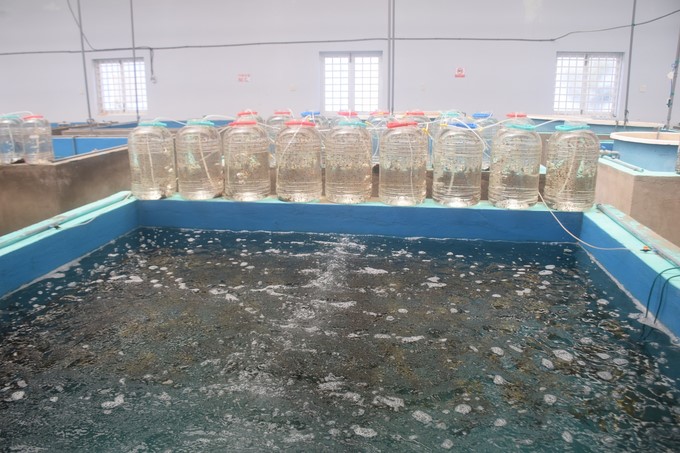
Smooth cottonii was tissue-cultured at DBLP Company (Phu Yen). Photo: V.D.T.
Seaweed grown in a shallow-water area also has the advantage that the grower can wade out to tie the seed ropes, whereas if growing seaweed in a deep-water area, the grower must operate on a coracle, which will delay the progress of the work and make it more laborious. According to Mr. Vinh, the best seaweed farming area is the area with a water level of 0.9m at the lowest tide and 2.7m at the highest tide. The seaweed growers must know how to dive to recover the broken seaweed to avoid loss and ensure income.
Through the practice at the commercial seaweed farming area of Okinawa Co., Ltd. in Song Cau town, the delegation of Binh Dinh fisheries industry grasped the basic knowledge of seaweed farming, which will be equipped for fishermen in the coastal area of Binh Dinh in the path of developing seaweed farming in the coming time.
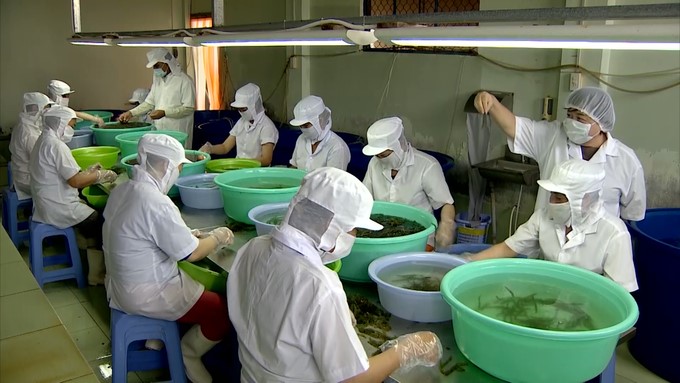
Seaweed is processed before being exported to the market. Photo: V.D.T.
"Seaweed will not grow if the salinity of the farming waters is above 35‰. If the salinity is too high, the seaweed’s body will be brittle and easily broken, but if the salinity is too low, below 27‰, the seaweed can't survive. The temperature on the water surface of the seaweed farming area also directly affects the growth of seaweed. If the temperature on the water surface of the farming area reaches 30oC, growers must watch; if the temperature increases to 32–34oC, it is necessary to let the hanging ropes sink deep to avoid heat, then the seaweed will grow stably," said Mr. Nguyen Ton Xuan Sang, Director of Nhon Hai Tourism and Fisheries Service Cooperative (Quy Nhon city).
Cottonii is becoming the most profitable seaweed variety. There are three species of cottonii, each serving different purposes. Of these, smooth cottonii is the highest-yielding species and becomes the most popular in the market. Smooth cottonii has a high starch content, so it is used to process confectionery, as human food, and for medical and industrial purposes. Thus, smooth cottonii always has a higher price than other seaweed varieties. As for thorny cottonii, it is often processed into salads to eat because it is very crispy, as is the green porcelain cottonii.
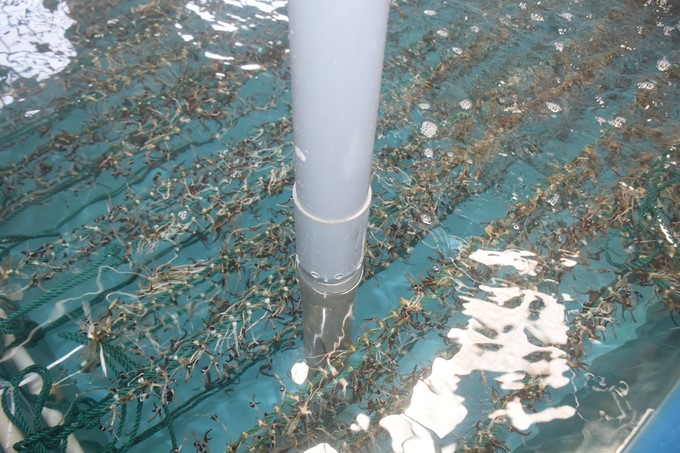
Seaweed seeds are raised in ponds at DBLP Company (Phu Yen). Photo: V.D.T.
Although growing smooth cottonii has higher economic efficiency than two varieties of thorny cottonii and green porcelain cottonii, it still has weaknesses compared to other varieties. For example, green porcelain cottonii can be grown year-round, while smooth cottonii can only be grown for two crops per year. However, green porcelain cottonii has a low starch content and is brittle.
"In Binh Dinh, if growing smooth cottonii, the growers should sow seeds 20 days before the Lunar New Year and wait until March on the lunar calendar next year to harvest, because then the windy season becomes hot, so the plants do not grow and output is low. During this time, farmers can switch to growing thorny cottonii for production and income during the year. Two months later, in the south wind season, we release the smooth cottonii to plant for the second crop. In August on the lunar calendar, it is harvested to avoid the rough sea season because, at this time, Binh Dinh is already in the stormy season. Nearing the Lunar New Year next year, continue to release the seeds to plant again. The smooth cottonii variety is suitable for the dry season but requires cool water, so it must be released at the end of December," said Mr. Nguyen Ton Xuan Sang.
According to Mr. Sang, during the break in the rough sea season, seaweed growers can keep the seed for the next crop to avoid the cost of buying seeds. When keeping varieties, it is necessary to avoid areas prone to sweetening. If the salinity of the seaweed seed farming waters drops to18‰, the seaweed will die out. The salinity should be 25‰ or higher.
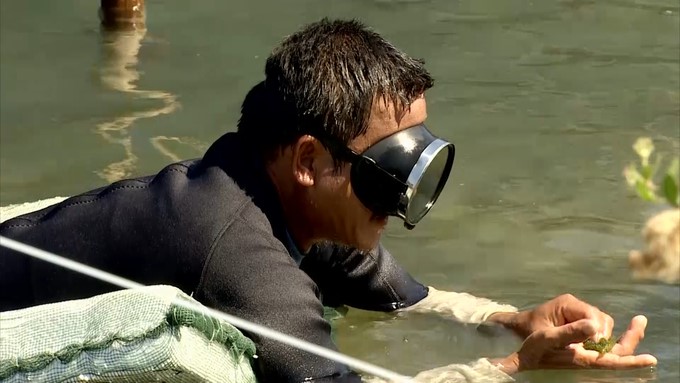
Seaweed growers inspect the growth of seaweed. Photo: V.D.T.
According to Mr. Le Trung Vinh, currently, smooth cottonii is grown most in Ninh Thuan to serve industry, and green porcelain cottonii is grown widely in Khanh Hoa to serve tourists. In Binh Dinh, seaweed mainly serves tourists, but most of the seaweed is harvested from nature and not yet cultivated. While Binh Dinh is currently booming in tourism, this becomes an opportunity for Binh Dinh to develop seaweed farming, both to supply the market and reduce exploitation affecting biodiversity.
"Cottonii has an average yield of 30 tons/ha/year. The selling price is about 0.1 USD/kg. The net profit is about 48 million/ha/year. This is thus a promising source of livelihood for coastal people. Besides being used as food and supplement food for humans, seaweed is also used in many fields such as food additives, animal feed, pharmaceuticals, cosmetics, textiles, biological fertilizers, bio-stimulants, bio-packaging, and biofuels", said Mr. Tran Dinh Luan, Director General of the Directorate of Fisheries.
Translated by Huyen Vu Thu
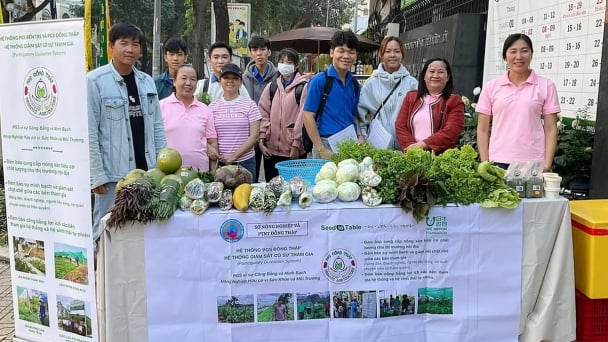
(VAN) Japan's grant aid project contributes to capacity building, promoting organic agricultural production, and fostering sustainable community development in Dong Thap province.
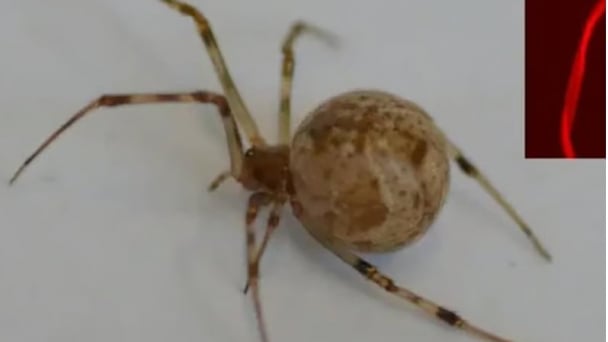
(VAN) For years, the CRISPR-Cas9 genome technology has been reshaping genetic engineering, a precision tool to transform everything from agriculture to medicine.
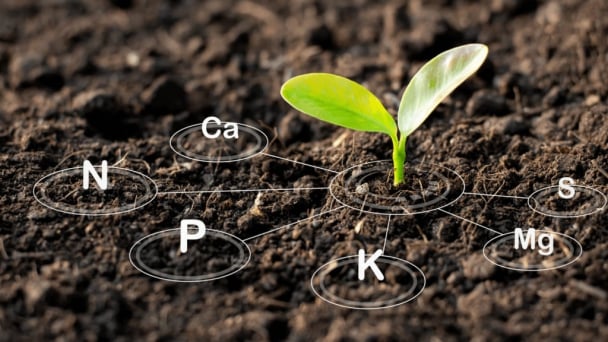
(VAN) Vietnam aims to become a 'leader' in the region in the capacity and managing effectively soil health and crop nutrition.
![Reducing emissions from rice fields: [Part 1] Farming clean rice together](https://t.ex-cdn.com/nongnghiepmoitruong.vn/608w/files/news/2025/05/05/z6509661417740_a647202949c539012a959e841c03e1d3-nongnghiep-143611.jpg)
(VAN) Growing clean rice helps reduce environmental pollution while increasing income, allowing farmers to feel secure in production and remain committed to their fields for the long term.
/2025/05/19/5136-1-144800_230.jpg)
(VAN) The Nghe An Provincial People's Committee has just approved the list of beneficiaries eligible for revenue from the Emission Reductions Payment Agreement (ERPA) in the North Central region for the year 2025.
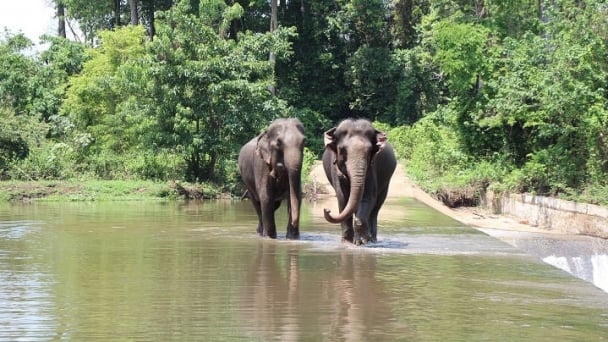
(VAN) 14 out of 35 domesticated elephants in Dak Lak province have had their living conditions improved, with 11 of them currently participating in the non-riding elephant tourism model.
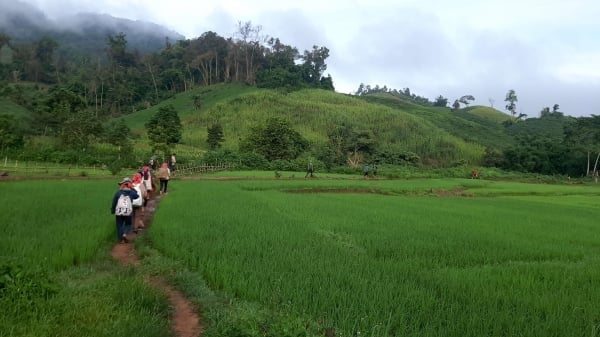
(VAN) Muong Nhe Nature Reserve hopes that being upgraded to a national park will lay the foundation for forest protection efforts to be carried out in a systematic, modern, and sustainable manner.